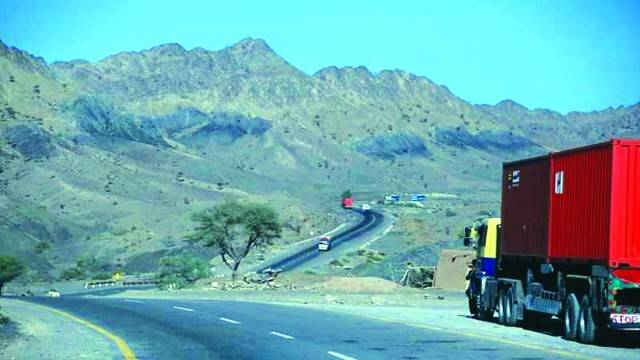
In the early hours of February 2, a passenger bus coming from Panjgur met an accident at Uthal. As many as 15 passengers were instantly killed in the accident and many others sustained serious injuries. This accident is another ghastly reminder of how killer highways of Balochistan continue to claim more lives than terrorist attacks.
In order to better understand the huge number of highway deaths in Balochistan, the People’s Primary Healthcare Initiative (PPHI) and Medical Emergency Response Centers (MERC) held a consultation meeting on the evening of February 2. This scribe attended that meeting. Here, five main problems causing highway accidents in Balochistan were discussed.
The first cause is the single carriageways of Balochistan. All highways in the province have single carriageways, which are used in two-lanes without a divider. When a speeding vehicle erroneously tries to overtake a slow-moving vehicle, it often collides with vehicles coming from the front. This is the most common form of highway accidents in Balochistan.
National Highway and Motorway Police (NH&MP) DIG Ali Sher Jhakrani revealed in the consultative meeting that almost 70 percent of highway accidents take place because of single carriageways. He lamented that Balochistan was the centre stage of the China-Pakistan Economic Corridor (CPEC) but could not use the opportunity to dualize a single highway.
The second cause of highway accidents, as discussed in the meeting, was the limited operations of NH&MP in Balochistan. The total length of provincial and federal highways in Balochistan, excluding the connecting roads, is 4,491 kilometres. Of this, NH&MP has jurisdiction only on a few hundred kilometres. Since NH&MP has to police the flow of traffic on highways, its absence makes the highways lawless. As a result, drivers do not follow the rules and end up causing catastrophic accidents.
The third cause of highway accidents as discussed in the meeting was reckless and unchecked driving by the drivers of long-range public transport coaches, especially on the Quetta-Karachi route. It is on this route that drivers move fast and cross the speed limits, which proves fatal given the single carriageway. Passenger coaches are often stopped for a long time at multiple check posts along the highway and in order to cover that lost time, they speed up their vehicles resulting in deadly accidents.
Transport secretary Bashir Ahmed Bangulzai revealed that 316 coaches operate on the Quetta-Karachi highway and the government was planning to install GPS trackers in all of them. “Using these trackers, we can find the coaches which are crossing the speed limit and then we will penalize them heavily once they reach their destinations,” he told the participants.
Other participants criticized the government of Balochistan for not developing a proper driving academy for drivers of coaches and buses. They noted that there are very few qualified public transport drivers in the province.
The fourth cause of highway accidents is the over-reliance on roads for goods transportation. DIG Jhakrani revealed that previously 90 percent of goods were transported using railways but this was shifted to highways due to certain vested interests. “Now the heavily loaded vehicles on highways are always slow-moving, which cause accidents on a routine basis,” he claimed. Shifting goods transportation from highways can ease the traffic flow, which in turn can reduce the number of accidents.
The fifth cause is the apathetic attitude of both the federal and provincial governments towards this issue. The federal government is not allocating funds for dualization of the Quetta-Karachi highway despite many protests in Balochistan. Meanwhile, the provincial government is not releasing timely funds for the MERC project, which it initiated to prevent loss of life in highway accidents.
MERC was established in February 2019 by the provincial government to provide emergency medical aid to victims of highway accidents. A data journalism story produced by this scribe proved that the fatality rate of highway accidents has fallen down by 30 times in Balochistan after the inception of MERC.

Aziz Jamali, founder and project director of MERC, told the meeting that eight centres are functional. He revealed that so far, the government had only released 17 percent of funds for this project. Despite the paucity of funds, the project has proven to be successful. Therefore, it is bizarre that the government of Balochistan is withholding funds for such lifesaving projects. MERC has been one of the rare success stories of Chief Minister Jam Kamal’s government.
This meeting deliberated on the causes of highway accidents. The details of this meeting were made available for the public. Participants of the meeting pressed on the need for data sharing between government departments so that the magnitude of the problem could be fully understood and investigated. Now, the ball is in the court of governments in Quetta and Islamabad to take the required action so that these causes can be addressed.
The writer is a journalist and researcher. He can be reached on Twitter @iAdnanAamir
In order to better understand the huge number of highway deaths in Balochistan, the People’s Primary Healthcare Initiative (PPHI) and Medical Emergency Response Centers (MERC) held a consultation meeting on the evening of February 2. This scribe attended that meeting. Here, five main problems causing highway accidents in Balochistan were discussed.
The first cause is the single carriageways of Balochistan. All highways in the province have single carriageways, which are used in two-lanes without a divider. When a speeding vehicle erroneously tries to overtake a slow-moving vehicle, it often collides with vehicles coming from the front. This is the most common form of highway accidents in Balochistan.
National Highway and Motorway Police (NH&MP) DIG Ali Sher Jhakrani revealed in the consultative meeting that almost 70 percent of highway accidents take place because of single carriageways. He lamented that Balochistan was the centre stage of the China-Pakistan Economic Corridor (CPEC) but could not use the opportunity to dualize a single highway.
The second cause of highway accidents, as discussed in the meeting, was the limited operations of NH&MP in Balochistan. The total length of provincial and federal highways in Balochistan, excluding the connecting roads, is 4,491 kilometres. Of this, NH&MP has jurisdiction only on a few hundred kilometres. Since NH&MP has to police the flow of traffic on highways, its absence makes the highways lawless. As a result, drivers do not follow the rules and end up causing catastrophic accidents.
The third cause of highway accidents as discussed in the meeting was reckless and unchecked driving by the drivers of long-range public transport coaches, especially on the Quetta-Karachi route. It is on this route that drivers move fast and cross the speed limits, which proves fatal given the single carriageway. Passenger coaches are often stopped for a long time at multiple check posts along the highway and in order to cover that lost time, they speed up their vehicles resulting in deadly accidents.
Transport secretary Bashir Ahmed Bangulzai revealed that 316 coaches operate on the Quetta-Karachi highway and the government was planning to install GPS trackers in all of them. “Using these trackers, we can find the coaches which are crossing the speed limit and then we will penalize them heavily once they reach their destinations,” he told the participants.
The government of Balochistan has been criticized for not developing a proper driving academy for drivers of coaches and buses
Other participants criticized the government of Balochistan for not developing a proper driving academy for drivers of coaches and buses. They noted that there are very few qualified public transport drivers in the province.
The fourth cause of highway accidents is the over-reliance on roads for goods transportation. DIG Jhakrani revealed that previously 90 percent of goods were transported using railways but this was shifted to highways due to certain vested interests. “Now the heavily loaded vehicles on highways are always slow-moving, which cause accidents on a routine basis,” he claimed. Shifting goods transportation from highways can ease the traffic flow, which in turn can reduce the number of accidents.
The fifth cause is the apathetic attitude of both the federal and provincial governments towards this issue. The federal government is not allocating funds for dualization of the Quetta-Karachi highway despite many protests in Balochistan. Meanwhile, the provincial government is not releasing timely funds for the MERC project, which it initiated to prevent loss of life in highway accidents.
MERC was established in February 2019 by the provincial government to provide emergency medical aid to victims of highway accidents. A data journalism story produced by this scribe proved that the fatality rate of highway accidents has fallen down by 30 times in Balochistan after the inception of MERC.

Aziz Jamali, founder and project director of MERC, told the meeting that eight centres are functional. He revealed that so far, the government had only released 17 percent of funds for this project. Despite the paucity of funds, the project has proven to be successful. Therefore, it is bizarre that the government of Balochistan is withholding funds for such lifesaving projects. MERC has been one of the rare success stories of Chief Minister Jam Kamal’s government.
This meeting deliberated on the causes of highway accidents. The details of this meeting were made available for the public. Participants of the meeting pressed on the need for data sharing between government departments so that the magnitude of the problem could be fully understood and investigated. Now, the ball is in the court of governments in Quetta and Islamabad to take the required action so that these causes can be addressed.
The writer is a journalist and researcher. He can be reached on Twitter @iAdnanAamir

